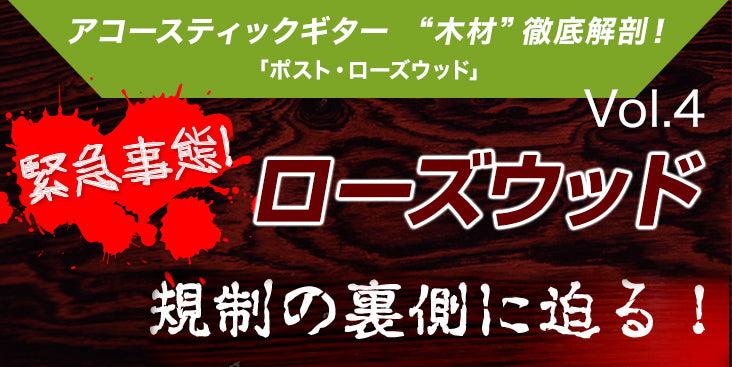New Hakaranda and other rare woods
The New Hakaranda and many other rosewood species have come to be treated as rare woods along with Hakaranda.
In that case, they have come forward,
The "post-rosewood" species have come forward to take the place of rosewood!
From the widely known species to the ones that are just........ From the well-known woods to the ones that are just not so well-known,
From the well-known woods to the new ones, each manufacturer is now using a wide range of woods!
This time, we have selected a wood that is not rosewood, but is a substitute for rosewood,
We would like to introduce some of the post-rosewood wood!
We would like to introduce some of the post-rosewood species, which, although not a rosewood species, is aiming for a place as a replacement for rosewood!

-
This wood is from the same Fabaceae family as rosewood, but it is not of the rosewood species, but of the genus Gibaultia, which has a high specific gravity and good stability.
Because of its high specific gravity and good stability, it is often used for the body and fingerboard of electric guitars.
Also known as "African rosewood," it is used by many brands in recent years as a substitute for rosewood because it has a sound similar to rosewood and is not designated on the red list.
Because of its beautiful grain, stability, and resistance to wear, it has been used for furniture for a long time.
Yokoyama Guitars
Tadashi Yokoyama, a former Morris craftsman and the developer of the Morris S Series, has a workshop in Nagano, Japan, where he makes guitars by himself.
The guitars are favored by fingerpickers and other skilled players, and each guitar made with his high level of woodworking skills has its own character and warmth. Each guitar is unique and warm, and features a wide range of specs using rare woods that other makers rarely use.
This is the AR-GBU from Yokoyama Guitars' most popular AR series.
The AR-GBU is a small-sized cutaway guitar with specifications based on the Morris S series, which is favored by many fingerpickers.
The side back of the Bubinga has a bright, light reddish color and a shimmering, quilt-like grain.The sound is hard and resilient like a Bubinga, not light but tight with a sense of specific gravity, making it a perfect match for Yokoyama Guitars.

-
This is Obancor, a leguminous wood belonging to the same genus as Bubinga, Gibaultia.
Compared to rosewood and bubinga, which have a strong reddish color, obancol has a yellowish brownish color. The grain pattern is similar to rosewood.
The dark grain lines and the lighter, yellowish areas are vivid and beautiful.
The sound quality is also close to rosewood, with a good tonal balance and a clear, contoured texture, but it is often slightly harder and brighter with a higher backbone than rosewood, and less wet than rosewood. It is also famous for its use in the Taylor 400 series, which is also known for the Taylor 414ce.
K.Yairi
K.Yairi was established in 1965 as a made-in-Japan brand, and from the 1970s to the present day, guitars made by a small team of handmade craftsmen have been supported by many players in every aspect, including precision, tone, and cost performance.

This is the "Shukugi" from K.Yairi's Cool Japan series, JAPONE, which is produced on an irregular basis. The distinctive top picture is painted by a technique called "wood burning," in which an electric pen is used to scorch the wood and create shades of gray. The oban call on the side back is a bright and beautiful one.
The unique sound, which is at once ataccented and bright, yet has a sense of boxy depth, is a combination of K.Yairi's handmade woody and warm sound, and the obangkor wood. -

This wood belongs to the same legume family as rosewood, and is a species of the genus Macaereum, which is closely related to the genus Crassostrea.
It is also called "Bolivian Rosewood" and "Santos Rosewood" in addition to "Purplewood" and "Morado," and has been used for side backs of acoustic guitars for a long time in the musical instrument industry. However, it is becoming more popular as a substitute material for rosewood under the regulation of rosewood.
The color of the wood varies from individual pieces, but ranges from chocolate brown to slightly purplish, with large, blurred stripes similar to those found on Indian Rose.
Morris
Morris is one of the most familiar domestic makers when discussing domestic forks.
The predecessor brand was founded in the 1960s, and in 1972 the brand name was changed to Morris.
The technical capabilities and prices of Morris forks are still highly regarded by many players today and in the past,
It is said that Morris dispelled the image of "cheap or bad" Japanese products from the end of the 1970s.
Morris has long used a wide range of woods for side backs, including Hakaranda, Indian rosewood, mahogany, nato, maple, and chestnut. This is Morris' reasonably priced dreadnought model, M501, named after purplewood with Perferro side backs.
The large, spreading grain of the board is dynamic and beautiful. The color is hard to see in the photo, but in person, it is a bit lighter and more purplish.

-
The wood grain is characterized by a light brown with bluish tints to a dark brownish grain with a chocolate-like color. It has a texture similar to alder.
The sound varies greatly depending on the wood grain and the individual piece, ranging from heavy like mahogany to light like mahogany.
Also known as "California Walnut," "Black Walnut," and "Claro Walnut," Claro Walnut has exotic grains such as curly, burl, and crotchet, and has been used for furniture for many years.
Gibson
Gibson is a brand that is indispensable when talking about acoustic guitars, and has established itself as one of the top two brands with Martin.
Since the 1930s and 1940s, Gibson has set various standards in the history of acoustic guitars, including the use of mahogany side backs and ebony fingerboards, and the use of maple for side backs, which other manufacturers were not actively using at the time. In recent years, due to the shortage of materials, Gibson has begun to use not only traditional woods but also woods that had not been used before.
This is a J-15, a round-shoulder type, starting with Gibson's traditional J-45.
Compared to the main regular models such as J-45 and J-50, the J-15 has been developed in recent years as a reasonable model.
Unlike the main mahogany model, the side backs are made of walnut and the necks are made of maple.
This model has a pleasantly deep attack that is bright and snappy. You can experience the good rise of the walnut without the loudness of the walnut.
Postscript
With the recent restrictions on rosewood in general, there has been an increase in the number of "post" rosewoods, such as these.
The spread of "post-rosewood" such as these has been widely spreading,
As in the case of New Hakaranda, it is not as a substitute material,
As was the case with new hakaranda, the appeal and value of the wood itself is increasingly being appreciated!
New varieties of rosewood are emerging, as well as other species,
Various new species of rosewood are emerging, and even other species are slipping into the role that rosewood used to play,
We are seeing more and more unique and attractive woods emerging from other species that are slipping into the roles that rosewood used to play,
Please keep an eye out for them!

